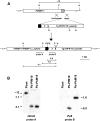A new rodent model to assess blood stage immunity to the Plasmodium falciparum antigen merozoite surface protein 119 reveals a protective role for invasion inhibitory antibodies
- PMID: 12963693
- PMCID: PMC2194199
- DOI: 10.1084/jem.20030085
A new rodent model to assess blood stage immunity to the Plasmodium falciparum antigen merozoite surface protein 119 reveals a protective role for invasion inhibitory antibodies
Abstract
Antibodies capable of inhibiting the invasion of Plasmodium merozoites into erythrocytes are present in individuals that are clinically immune to the malaria parasite. Those targeting the 19-kD COOH-terminal domain of the major merozoite surface protein (MSP)-119 are a major component of this inhibitory activity. However, it has been difficult to assess the overall relevance of such antibodies to antiparasite immunity. Here we use an allelic replacement approach to generate a rodent malaria parasite (Plasmodium berghei) that expresses a human malaria (Plasmodium falciparum) form of MSP-119. We show that mice made semi-immune to this parasite line generate high levels of merozoite inhibitory antibodies that are specific for P. falciparum MSP-119. Importantly, protection from homologous blood stage challenge in these mice correlated with levels of P. falciparum MSP-119-specific inhibitory antibodies, but not with titres of total MSP-119-specific immunoglobulins. We conclude that merozoite inhibitory antibodies generated in response to infection can play a significant role in suppressing parasitemia in vivo. This study provides a strong impetus for the development of blood stage vaccines designed to generate invasion inhibitory antibodies and offers a new animal model to trial P. falciparum MSP-119 vaccines.
Figures





Similar articles
-
Merozoite Surface Protein 1 from Plasmodium falciparum Is a Major Target of Opsonizing Antibodies in Individuals with Acquired Immunity against Malaria.Clin Vaccine Immunol. 2017 Nov 6;24(11):e00155-17. doi: 10.1128/CVI.00155-17. Print 2017 Nov. Clin Vaccine Immunol. 2017. PMID: 28877929 Free PMC article.
-
Immunity to recombinant plasmodium falciparum merozoite surface protein 1 (MSP1): protection in Aotus nancymai monkeys strongly correlates with anti-MSP1 antibody titer and in vitro parasite-inhibitory activity.Infect Immun. 2006 Aug;74(8):4573-80. doi: 10.1128/IAI.01679-05. Infect Immun. 2006. PMID: 16861644 Free PMC article.
-
Antibodies against merozoite surface protein (MSP)-1(19) are a major component of the invasion-inhibitory response in individuals immune to malaria.J Exp Med. 2001 Jun 18;193(12):1403-12. doi: 10.1084/jem.193.12.1403. J Exp Med. 2001. PMID: 11413195 Free PMC article.
-
Towards an RTS,S-based, multi-stage, multi-antigen vaccine against falciparum malaria: progress at the Walter Reed Army Institute of Research.Vaccine. 2005 Mar 18;23(17-18):2243-50. doi: 10.1016/j.vaccine.2005.01.142. Vaccine. 2005. PMID: 15755604 Review.
-
Merozoite surface protein 1, immune evasion, and vaccines against asexual blood stage malaria.Parassitologia. 1999 Sep;41(1-3):409-14. Parassitologia. 1999. PMID: 10697894 Review.
Cited by
-
Construction of transgenic Plasmodium berghei as a model for evaluation of blood-stage vaccine candidate of Plasmodium falciparum chimeric protein 2.9.PLoS One. 2009 Sep 3;4(9):e6894. doi: 10.1371/journal.pone.0006894. PLoS One. 2009. PMID: 19727400 Free PMC article.
-
Growth-inhibitory antibodies are not necessary for protective immunity to malaria infection.Infect Immun. 2010 Feb;78(2):680-7. doi: 10.1128/IAI.00939-09. Epub 2009 Nov 16. Infect Immun. 2010. PMID: 19917716 Free PMC article.
-
A newly discovered protein export machine in malaria parasites.Nature. 2009 Jun 18;459(7249):945-9. doi: 10.1038/nature08104. Nature. 2009. PMID: 19536257 Free PMC article.
-
Tailoring subunit vaccine immunogenicity: maximizing antibody and T cell responses by using combinations of adenovirus, poxvirus and protein-adjuvant vaccines against Plasmodium falciparum MSP1.Vaccine. 2010 Oct 18;28(44):7167-78. doi: 10.1016/j.vaccine.2010.08.068. Vaccine. 2010. PMID: 20937436 Free PMC article.
-
Results from tandem Phase 1 studies evaluating the safety, reactogenicity and immunogenicity of the vaccine candidate antigen Plasmodium falciparum FVO merozoite surface protein-1 (MSP1(42)) administered intramuscularly with adjuvant system AS01.Malar J. 2013 Jan 23;12:29. doi: 10.1186/1475-2875-12-29. Malar J. 2013. PMID: 23342996 Free PMC article. Clinical Trial.
References
-
- Richie, T.L., and A. Saul. 2002. Progress and challenges for malaria vaccines. Nature. 415:694–701. - PubMed
-
- Lyon, J.A., A.W. Thomas, T. Hall, and J.D. Chulay. 1989. Specificities of antibodies that inhibit merozoite dispersal from malaria-infected erythrocytes. Mol. Biochem. Parasitol. 36:77–85. - PubMed
-
- Brown, G.V., R.F. Anders, G.F. Mitchell, and P.F. Heywood. 1982. Target antigens of purified human immunoglobulins which inhibit growth of Plasmodium falciparum in vitro. Nature. 297:591–593. - PubMed
Publication types
MeSH terms
Substances
LinkOut - more resources
Full Text Sources
Other Literature Sources
Research Materials

